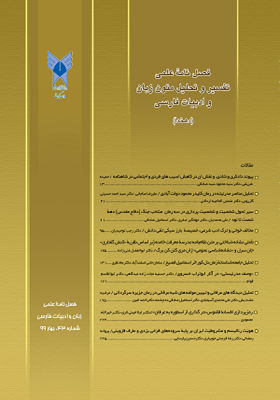تحلیل جامعه شناسانۀ رُمان دل کور اثر اسماعیل فصیح
محورهای موضوعی : متون زبان و ادبیات فارسیسامان خانی اسفند آباد 1 , ماه نظری 2 *
1 - دانشجوی دکتری زبان و ادبیات فارسی، واحد کرج، دانشگاه آزاد اسلامی، کرج، ایران
2 - دانشیار گروه زبان و ادبیات فارسی، واحد کرج، دانشگاه آزاد اسلامی، کرج، ایران
کلید واژه:
چکیده مقاله :
جامعه شناسی ادبیات، بررسی متون ادبی، از نگاه جامعه شناختی است که رابطۀ بین ادبیات و عناصر اجتماعی را نشان می دهد. در واقع این نوع تحلیل به بررسی تأثیر متقابل ادبیات و جامعه بر همدیگر می پردازد. خوانشِ متفاوت اثر ادبی، فرآیندی است دو سویه بین نویسنده و خواننده. اهمیت آن از آنجایی است که سنّت های ادبی در پی مطلق گرایی معنا هستند، نگاهی تک بعدی که انسان مُدرن، آن را برنمی تابد و به نوعی خواننده را دچار بی میلی می کند. اما نقد بر پایۀ جامعه شناسی به عنوان یک تحلیل جدید، باعث پیوند ذهن خواننده با ابعاد مختلف زیبایی شناسی متن می گردد. برای این منظور رُمان دل کور اسماعیل فصیح که دوران مختلف پرالتهاب تاریخ ایران از جمله سال های حکومت پهلوی و انقلاب مشروطه را در برمی گیرد، مورد نقد جامعه شناختی قرار گرفته تا ارتباط ادبیات با محیط و طبقات اجتماعی آن عصر را نشان دهد. در این پژوهش، ابتدا به تشریح نظریات نقد جامعه شناسی ادبیات و دسته بندی مؤلفه های جامعه شناسانه از دیدگاه گلدمن، لوکاچ، باختین و اسکارپیت پرداخته شده سپس این مؤلفه ها در بافت جامعۀ موردِ نظرِ نویسنده پیاده شدند تا بتوانیم نوع زندگی مردم، طبقات اجتماعی مختلف به خصوص قشر مستضعف و پایین جامعه، مشاغل آنها، جایگاه اجتماعی زنان و محرومیت هایشان ، مباحث تاریخی، زیرساخت های اجتماعی، نبود بهداشت، شیوع بیماری ها و قحطی، استفاده از طب سنتی به جای درمان های به روز، آسیب های اجتماعی، فقر، فحشا، تجاوز، خشونت، رباخواری، اسیدپاشی، باورهای مذهبی،باورهای عامیانه، خرافات آن عصر و ... را بهتر درک کنیم. لازم به ذکر است این تحقیق به روش توصیفی – تحلیلی انجام پذیرفته است.
The sociology of literature is the study of literary texts from a sociological point of view that illustrates the relationship between literature and social elements. In fact, this type of analysis examines the interplay between literature and society. A different reading of literary work is a two-way process between author and reader. It is important because literary traditions seek for absolutism of meaning, a one-dimensional view that the modern man does not tolerate, and in some way disgusts the reader. But critiques based on sociology as a new analysis make the reader's mind link to different aspects of the text's aesthetics. To this end, the novel by Isma’il Fasih Del Koor, which covers various prominent periods of Iranian history, including the years of Pahlavi rule and the constitutional revolution(Enghelabe Mashrouteh), has been critiqued sociologically to illustrate the relation of literature to the environment and social classes of that era. In this study, we first outline the theories of critique of sociology of literature and categorize sociological components from Goldmann, Lukacs, Bakhtin, and Escarpit's viewpoints and then apply them to the context of the author's intended community so that we can understand the life style of people, classes Different societies, especially the weak and low-income classes, their occupations, women's social status and their deprivation, historical issues, social infrastructure, lack of health, prevalence of diseases and famines, use of traditional medicine in lieu of up-to-date treatments, social injuries , Poverty, Prostitution, Rape, Violence, Usury, Acid Spraying, Religious Beliefs, Popular Beliefs Yeah, we better understand the superstitions of that era and ... It should be noted that this research has been done by "descriptive - analytical" method.
کتاب ها
مقاله ها
_||_

